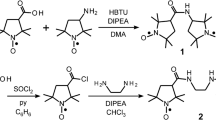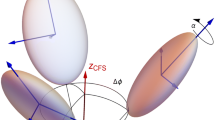Abstract
In high-spin chemistry, random-orientation fine-structure electron paramagnetic resonance (FS ESR) spectroscopy holds the advantages of the most facile and convenient method to identify high-spin systems. The FS ESR spectroscopy for high spins in frozen rigid glasses has seemingly been well established since the first spin-quintet m-dicarbene and m-dinitrene appeared in 1967. The FS ESR spectra of organic quintet entities generated by photolysis in the 2-methyltetrahydrofuran (2-MTHF) glass, however, have never been fully analyzed due to a peculiar line broadening appearing at many canonical peaks. The line broadening has been a notorious obstacle that masks key FS transitions of many cases in organic glasses or argon matrices. We examine the origin of the line broadening, illustrating the comprehensive spectral analysis for m-dinitrenes and other types of typical quintet-state dinitrenes observed in the 2-MTHF glass. Our new approach to the line broadening analysis invokes both exact analytical solutions for the resonance fields of canonical peaks and a magnetic-parameter gradient method. We have derived the exact analytical expressions for FS canonical peaks for high-spin states, for the first time. A microscopic origin of the line broadening observed for high-spin nitrenes generated by photolysis in rigid glasses is proposed on the basis of quantum chemical calculations of the D-tensor.












Similar content being viewed by others
Notes
The contribution to the peculiar line broadening from the hyperfine couplings of the two nitrogen nuclei at the nitrene sites has been examined in the FS spectral simulations. The peculiar line broadening exceeds the hyperfine anisotropy.
Our homebuilt programs based on the second- and third-order perturbation theory have been used for simulating some quintet FS X-band ESR spectra from dinitrenes in organic rigid glasses by Iwamura’s group.
References
P.M. Lahti (ed.), Magentic Properties of Organic Materials, chapt. 11, pp. 197–236 (Marcel Dekker; New York, 1999)
K. Itoh, M. Kinoshita (eds.), Molecular Magnetism: New Magnetic Materilas (Kodansha and Gordon & Breach, Tokyo/Amsterdam, 2000)
A. Lund, M. Shiotani (eds.), EPR of Free Radicals in Solids. Trends in Methods and Applications, chapt. 11, pp. 407–490; chapt. 12, pp. 491-528 (Kluwer, Dordrecht, 2003)
K. Itoh, T. Takui, Y. Teki, T. Kinoshita, J. Mol. Electron. 4, 181–186 (1988)
K. Itoh, T. Takui, Proc. Jpn Acad. Ser. B 80, 29–40 (2004)
M. Baumgarten, Gherghel, T. Wehrmeister, Chem. Phys. Lett. 267, 175 (1997)
T. Sawai, K. Sato, T. Ise, D. Shiomi, K. Toyota, Y. Morita, T. Takui, Angewandte Chemie, Int. Ed. 47, 3989–3990 (2008)
S. Nakazawa, K. Sato, D. Shiomi, M.T.M.B. Franco, M.C.R.L.R. Lazana, M.C.B.L. Shohoji, K. Itoh, T. Takui, Inorg. Chim. Acta 361, 4031–4037 (2008)
Y. Morita, S. Suzuki, K. Fukui, S. Nakazawa, H. Kitagawa, H. Kishida, H. Okamoto, A. Naito, A. Sekine, Y. Ohashi, M. Shiro, K. Sakaki, D. Shiomi, K. Sato, K. Nakasuji, T. Takui, Nat. Mater. 7, 48–51 (2008)
Y. Morita, K. Fukui, S. Nakazawa, K. Tamaki, A. Fuyuhiro, K. Yamamoto, K. Sato, D. Shiomi, T. Takui, K. Nakasuji, Angew. Chem. Int. Ed. 41, 1793–1796 (2002)
J. Inoue, K. Fukui, S. Nakazawa, K. Sato, D. Shiomi, K. Yamamoto, T. Takui, K. Nakasuji, J. Am. Chem. Soc. 123, 12702–12703 (2001)
M.C.B.L. Shohoji, M.L.T.M.B. Franco, M.C.R.L.R. Lazana, S. Nakazawa, K. Sato, D. Shiomi, T. Takui, J. Am. Chem. Soc. 122, 2962–2963 (2001)
K. Sugisaki, K. Toyota, K. Sato, D. Shiomi, T. Takui, Angew. Chem. Int. Ed. 45, 2962–2963 (2006)
K. Sato, M. Yano, M. Furuichi, D. Shiomi, T. Takui, K. Abe, A. Higuchi, K. Katsuma, Y. Shirota, J. Am. Chem. Soc. 119, 6607–6613 (1997)
K. Sato, S. Nakazawa, R. Rahimi, T. Ise, S. Nishida, T. Yoshino, N. Mori, K. Toyota, D. Shiomi, Y. Yakiyama, Y. Morita, M. Kitagawa, K. Nakasuji, M. Nakahara, H. Hara, P. Carl, P. Hoefer, T. Takui, J. Mat. Chem. 19, 3739–3754 (2009)
K. Itoh, Chem. Phys. Lett. 1, 235–238 (1967)
E. Wasserman, R.W. Murray, W.A. Yager, A.M. Trozzolo, G. Smolinsky, J. Am. Chem. Soc. 89, 5076–5078 (1967)
A.M. Trozzolo, R.W. Murray, G. Smolinsky, W.A. Yager, E. Wasserman, J. Am. Chem. Soc. 85, 2526-2528 (1963)
E. Wasserman, L.C. Snyder, W.A. Yager, J. Chem. Phys. 41, 1763–1772 (1964)
S.V. Chapyshev, R. Walton, J.A. Sanborn, P.M. Lahti, J. Am. Chem. Soc. 122, 1580–1588 (2000)
S. Murata, H. Iwamura, J. Am. Chem. Soc. 113, 5547–5556 (1991)
S.V. Chapyshev, H. Tomioka, Bull. Chem. Soc. Jpn. 76, 2075–2089 (2003)
R.S. Kalgutkar, P.M. Lahti, Tetrahedron Lett. 44, 2625–2628 (2003)
A.S. Ichimura, K. Sato, T. Kinoshita, T. Takui, K. Itoh, P.M. Lahti, Mol. Cryst. Liq. Cryst. Sect. A 272, 57–66 (1995)
S.V. Chapyshev, D. Grote, C. Finke, W. Sander, J. Org. Chem. 73, 7045–7051 (2008)
N. Oda, T. Nakai, K. Sato, D. Shiomi, M. Kozaki, K. Okada, T. Takui, Synth. Met. 121, 1840–1841 (2001)
T. Koto, K. Sato, D. Shiomi, K. Toyoda, K. Itoh, E. Wasserman, T. Takui, J. Phys. Chem. A 113, 9521–9526 (2009)
W. Adam, C. van Barneveld, S.E. Bottle, H. Engert, G.R. Hanson, H.M. Harrer, C. Heim, W.M. Nau, D. Wang, J. Am. Chem. Soc. 118, 3974–3975 (1996)
K. Sato, Ph.D. Thesis, Osaka City University, 1994
The download site is as follows: http://www.sci.osaka-cu.ac.jp//chem/phy2/download.html
S. Stoll, A. Schweiger, J. Magn. Reson. 178, 42–55 (2006)
J.A. Hebden, C.A. McDowell, J. Magn. Reson. 5, 115–125 (1971)
T. Koto, Ph.D. Thesis, Osaka City University, 2009
T.A. Fukuzawa, M.S. Thesis, Osaka City University, 1996
T.A. Fukuzawa, K. Sato, A.S. Ichimura, T. Kinoshita, T. Takui, K. Itoh, P.M. Lahti, Mol. Cryst. Liq. Cryst. Sect. A 278, 253–260 (1996)
S.V. Chapyshev, R. Walton, P.R. Serwinski, P.M. Lahti, J. Phys. Chem. A 108, 6643–6649 (2004)
Y. Teki, T. Takui, K. Itoh, J. Chem. Phys. 88, 6134–6145 (1988)
T. Matsumoto, T. Ishida, N. Koga, H. Iwamura, J. Am. Chem. Soc. 114, 9953–9959 (1992)
C. Ling, M. Minato, P.M. Lahti, H. van Willigen, J. Am. Chem. Soc. 114, 9959–9969 (1992)
Acknowledgments
This work has been supported by Grants-in-Aid for Scientific Research from the Ministry of Education, Science, Sports and Culture, Japan and partly by Core Research for Evolutional Science and Technology (CREST), Japan Science and Technology Agency (JST), Japan.
Author information
Authors and Affiliations
Corresponding authors
Additional information
Koichi Itoh: deceased on June 27, 2008.
Appendix: Exact Analytical Expressions of Resonance Fields for Canonical Orientations of High-Spin States
Appendix: Exact Analytical Expressions of Resonance Fields for Canonical Orientations of High-Spin States
We present useful mathematical expressions to obtain the energy eigenvalues and resonance fields (eigenfields) derived from the spin Hamiltonian with the magnetic field parallel to the principal axes of the D-tensor. These expressions are exact and valid for an anisotropic g-tensor under the assumption of the colinearity between the g- and D-tensors. Analytical formulas for exact transition probabilities are not presented here. The expressions for the magnetic field parallel to the X and Y axes are straightforwardly obtained by the cyclic permutation with respect to X, Y, and Z:
In the present description, the FS parameters D and E are defined as
Since the analytically derived expressions for the eigenfield solution of a cubic or quartic equation are extremely complicated, the original cubic or quartic equation is presented here. More detailed expressions are available in the download site [29, 30]. These equations can analytically be solved using Cardano’s formula for the cubic equation or Ferrari’s formula for the quartic equation without mathematical difficulty. The possibility of obtaining the analytical solutions is summarized in Table 1.
1.1 The Triplet State (S = 1)
It is well known that both the energy eigenvalues and resonance fields can exactly be solved for an arbitrary direction of the magnetic field as indicated in Table 1. Since the equations giving them are lengthy, only a relevant part of them is given here. They are obtained using the secular equations for the energy eigenvalues and resonance fields, respectively. The secular equation of the spin Hamiltonian for S = 1 is cubic in the eigenvalue w, whereas, the secular equation for the resonance field gives an equation cubic in H 2. Both of these equations can be exactly and analytically solved.
The three energy eigenvalues of the spin Hamiltonian with the magnetic field parallel to the principal Z axis of the D tensor are given by
For resonance fields, the eigenfields for the Z-canonical orientation are given by
1.2 The Quartet State (S = 3/2)
In a manner similar to the triplet state, the corresponding energy eigenvalues and resonance fields can be exactly obtained. The four energy eigenvalues are given by
The maximum number of the transitions of the quartet state is six, which corresponds to the number of pairs of levels chosen among the four spin sublevels. Two sets of the eigenfields are given by
noting the difference in sign. The remaining other eiegenfields are obtained by solving the following equation, which is quartic in H 2:
1.3 The Quintet State (S = 2)
The two of five energy eigenvalues are given by
The others are obtained by the following cubic equation:
For the quintet case, the maximum number of the transitions is ten. One of the ten eigenfields is
The others are acquired using the following three equations cubic in H 2:
1.4 The Sextet State (S = 5/2)
The six energy eigenvalues are obtained from the following two equations cubic in w:
Canonical resonance eigenfields are obtained by solving the following two equations in H 2:
where
and
where
1.5 General Solutions for Cubic and Quartic Equations
In the following, general solutions for cubic and quartic equations are explicitly given, and thus all the exact analytical formulas necessary for the canonical eigenfields and the corresponding partial differentials can be acquired:
where
where
Rights and permissions
About this article
Cite this article
Koto, T., Sugisaki, K., Sato, K. et al. High-Spin Nitrene Fine-Structure ESR Spectroscopy in Frozen Rigid Glasses: Exact Analytical Expressions for the Canonical Peaks and A D-Tensor Gradient Method for Line Broadening. Appl Magn Reson 37, 703 (2010). https://doi.org/10.1007/s00723-009-0056-9
Received:
Revised:
Published:
DOI: https://doi.org/10.1007/s00723-009-0056-9




